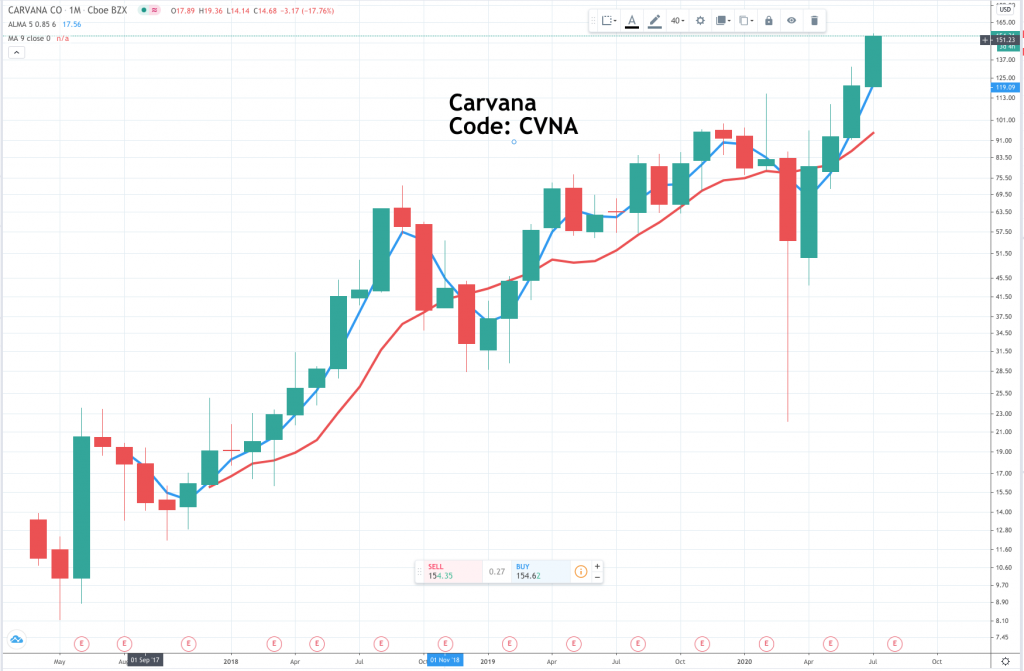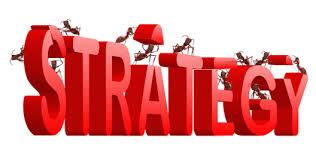
The battle for territory and how Carvana is winning it in the huge US used car market

Carvana/ CVNA Buy @ $151.26 MV: $10.6bn Employees: 7,324 Next figures: 5 August
I think Carvana is a stunningly exciting business with huge potential. This is what Ernie Garcia 111, the 37 year-old CEO and co-founder, had to say in the 2019 report and accounts, published in early 2020.
““We believe we are standing today at the foot of the same curve we stood in front of seven years ago. We are still so small compared to what we can be that our progress to this point barely registers against the scale of the opportunity in front of us. As we have for the last seven years, we will keep working hard, learning quickly, and having fun. And we will keep you informed along the way.”
He is a positive guy, obviously but looking at what he and his colleagues have achieved over the seven years to date, you can see why they are excited. I too believe that Carvana is closer to the beginning than the end or even the middle of what could be a spectacular growth story. I also like them because they are such a perfect example of a phenomenon, which explains a great deal about what is happening in global and especially US stock markets.
I am talking about the battle for territory. The companies whose shares you want to buy are the companies which are winning this battle. Another way of looking at it is the battle for market share. Again Garcia expressed it perfectly.
“I think what we are most excited about is, first and foremost, the market share that we’ve kind of always been planning to go after and take over time. We’ve been growing our business very quickly prior to this as a result of our extremely differentiated offering, and all the customer preferences that, that serves. And I think that in this new world, we now know the direction of a new customer preference, which is a preference for safety and minimising unnecessary impact with other people that customers don’t know as well. We know that that’s likely to push demand in our direction and aid our goals of increasing our market share. We don’t know how strong that impact will be. We don’t know how persistent it will be, but it’s pretty clear that’s a directional impact. And we think that overall, when assessing Carvana, what matters most is our market share gains. The market around us is extraordinarily large. And we’re still very, very small compared to that market.”
This is my new mantra. In property it is location, location, location; in the stock market its market share, market share, market share. The companies, which win the market share battles win the war.
This battle for territory is something primordial. As soon as homo sapiens becomes active in an area other large predators seem to become extinct. What have humans mostly fought over in historical times, it’s territory every time even if it is dressed up as religious or national differences.
Investors in the past and often still have judged companies by metrics such as asset backing, dividend yields and PE ratios but the struggle, especially when global markets are up so acceissible, seems to be increasingly about market share and land grabs.This makes sense when you consider that in the globalised, technology era we increasingly see whole industries being disrupted by new entrants, when we have learned about phenomena such as first mover advantage and winner takes all and when the strongest performers in a sector benefit from powerful network effects and virtuous circles of growth that put them in increasingly strong positions.
Against that background let us look at Carvana. One of the simplest indicators that a company is gaining market share is that it is growing faster than the market. An even simpler indicator is explosive growth pure and simple. If a company is growing explosively it is obviously gaining market share, probably very rapidly, which is another reason why really fast growing businesses are such exciting investments.
The best indicator of success for a used car business is units sold. These are the figures for Carvana between 2014 and calendar 2019 – 2,105, 6,523, 18,761, 44,252, 94,108 and 177,549. Prior to Covid-19 the business was on fire, which explains the ebullience of the quote from the 2019 accounts. Then came Covid-19 and momentarily the bottom fell out of the market.
“We began to see significant reductions in demand in the back half of March with a sales trough in early April at approximately 30pc reduction in sales year-over-year. From there, we have consistently improved week after week, with sales in the most recent weeks being up about 20pc to 30pc year-over-year.
The company reacted dramatically with pay cuts across the workforce including the directors giving up their pay completely and even a fund set up to help employees who experienced difficulties from the pay cuts. The group also put in place a $2bn loan facility and raised an additional $600m equity capital to make sure it had the balance sheet strength to cope with anything which might happen.
There was a reason for this cautious approach because Carvana has been deliberately designed to have high fixed costs and low variable costs, almost the opposite of the traditional used car business model. High fixed costs make you vulnerable if there is an external shock that sharply reduces demand in what was expected to be the busiest month, March, of the year.
“I think this business is designed to swap variable costs for fixed cost relative to the traditional model. And we think that is absolutely the right move. And in no way, shape or form, would we want to change that at all? I think the degree to which that ends up being the right choice is a function of the size of the business that you believe you can ultimately build. And prior to this, we believed that we could build a business that would sell 2 million-plus cars per year and that, that would lead to us being the largest most profitable automotive retailer, and I don’t think we have any information that would cause us to question that in any way, shape or form. I think if anything that the information that’s changed would potentially make us more optimistic about the speed to getting there or even the possible ultimate upside.
So I think we feel very good about the way we’ve designed the business and think it positions us incredibly well to continue growth. I think we’ve also demonstrated a lot of flexibility in the model. This point is that we’ve built a business that is set up to have higher fixed costs and lower variable costs. That’s an incredible setup when you’re growing very quickly and when you’re looking at the long-term with these large market shares but that’s a really tough setup when you’re looking at a discontinuous demand shock, like the one that we just saw over the last five or six weeks. I think the business also demonstrated its flexibility and our ability to pull levers and kind of size it down and pull in our wings and adjust quickly to a lower demand environment. And then it’s shown its ability to spring back up over the last couple of weeks. So we feel great about the business that we designed and think, if anything, the future is brighter.”
That quote incidentally gives an idea of the ambitions of these guys. Their target is to sell at least 11-fold the number of cars they sold last year. Indeed it is not just them who feel so positive on prospects. One analyst had this to say about Carvana.
“Carvana is a rapidly growing online retailer of used cars in the U.S. After launching in its first market, Atlanta, in 2013, the company has quickly exploded to become the third-largest used car retailer in the country with 177,549 retail used cars sold last year. But the company is still just getting started for two key reasons.
First, Carvana has developed a fundamentally better economic model for selling used cars. Its online model allows it to grow without the limitation of having to build expensive brick-and-mortar dealerships. At the same time, its nationwide inventory pool allows its customers to browse over 20,000 cars at once — a far larger selection than is available at any single physical dealership, which typically carries no more than a few hundred cars. Additionally, Carvana’s nationwide logistics and delivery network allows the company to deliver any one of these cars to customers’ driveways across the country.
Not only should this used car model scale much better over time than the physical dealership model, customers appreciate it much more. Shopping for a used car is a notoriously unpleasant customer experience, but Carvana’s selling experience has earned it a Net Promoter Score (“NPS”) of 82 as of last year. For context, an NPS score above 0 is considered “good,” above 50 “excellent,” and above 70 “world class.”
Second, the used car market is so fragmented that the No. 1 player, Car Max, has only about 2pc national market share. The top 100 players have less than 9pc market share combined. This wide fragmentation is due to the fact that it’s extremely difficult to differentiate oneself and scale by selling used cars the traditional way at physical locations.
But an online-only model with massive inventory and home delivery scales so much better, which explains why the company has grown so quickly. In Atlanta, Carvana already has over 2pc market share, matching CarMax’s nationwide footing.
Additionally, Carvana is one of the few retailers that is benefiting from the COVID-19 pandemic. While the company’s sales tanked about 30pc year over year at their worst point in early April, sales quickly returned to 20pc to 30pc year-over-year growth toward the end of that month. That’s better than the industry and has been driven by the natural appeal of Carvana’s online model and its fantastic customer experience.”
Carvana shares have traditionally been volatile and that may continue in future but long-term I see them going much higher. They really do look like the Amazon of the used car business.

I will discuss it further in future issues but if you judge companies by their ability to gain market share it explains a great deal both about their quality as investments and their likely strategy as businesses. In a nutshell it makes great sense to sacrifice short-term profits for long-term gains in market share. The ultimate prize, one which Carvana looks well-placed to win, is a company that becomes the market share leader in its sector. Very often, this will come about because the company is disrupting the way things are done in the sector, which again perfectly describes Carvana and many other shares in the QV portfolio. Winners enter virtuous circles where they grow faster, generate more free cash flow, attract higher quality employees, are able to invest more in sales and marketing and research and development, which strengthens their position even further ad infinitum or until a new disruptor comes along.



